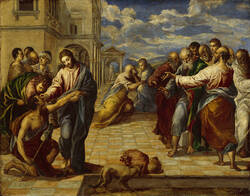In the left foreground Christ heals the blind man, shown kneeling in front of him, while the men standing around the scene discuss the miracle. A striking feature of the painting is the way the buildings recede towards a vanishing point in the background. El Greco (“the Greek”), who had been trained as an icon painter in his homeland of Greece, learned how to create linear perspective during his stay in Italy, where this form of representing architecture had been developed in the 15th century.
Further Media
Even late into the nineteenth century, art experts believed the Healing of the Blind was the work of a Venetian painter – and for very good reasons. In this work, El Greco impressively shows the lessons he learnt from the work of the great Venetian artists.
The painting is composed in perfect single-point perspective – as you can tell from the edges of the rows of tiles on the ground, aligned with the same vanishing point. This linear perspective is further emphasised by the architecture of the building on the left, skilfully foreshortened. In his native Crete, El Greco trained as an icon painter – a genre which does not use perspectival space. It was in Venice that El Greco learnt to paint his compositions in single-point perspective.
His colour palette is another factor linking this work to Venetian art. The use of rich, luminous colours was the signature feature of Venetian Renaissance painting. Just like the Venetian artists, El Greco applied the pigments in a more or less loose brushstroke which remains visible.
The bright reflections of light on the luxuriant drapery folds are another remarkable feature – evident, for instance, to the left of Jesus, on the figure bending down to the blind man’s face.
Moreover, we know El Greco cited some figures from Venetian paintings in this work – the inspiration for the man in a turban to the left of Jesus came from a painting by Titian.
- Location & Dating
- c. 1570
- Material & Technique
- Mixed media on poplar panel
- Dimenions
- 65,5 x 84 cm
- Museum
- Gemäldegalerie Alte Meister
- Inventory number
- Gal.-Nr. 276

